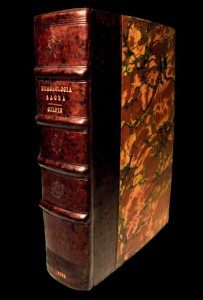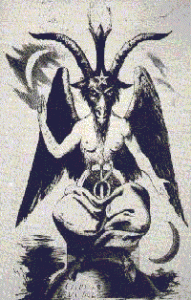“All gods are homemade, and it is we who pull their strings, and so, give them the power to pull ours.” – Aldous Huxley
Once considered to be the leader of modern thought, and widely regarded as an intellectual of the highest calibre, Aldous Huxley gave us a glimpse of his theistic genius in the above quote, but the one flaw in that statement, to my mind, is the omission of an entire class of deistic entities, a corpus of religious manipulation that may hold the power to destroy mankind. [1] That omission may have been innocent, it may have been deliberate, or more likely it was the same simple oversight that the majority of those who think about such ideas commits in their earnest attempt to decipher the riddles of human theistic invention.
Why does God command such attention, when there are much more dangerous ideas lain beside him?
Perhaps he said it better here:
“Most human beings have an absolute and infinite capacity for taking things for granted” –Aldous Huxley
He was not talking about stopping to smell the roses; he was not talking about spending more time with family, and in point of fact, what he was talking about is almost irrelevant. Those words are more poignant in religious discussion than under any other principle. What we take for granted are simple facts, simple ideas and simple connections. We collectively gravitate toward the complex, fanciful and altogether ridiculous ideas of dogma, and only when convenient or trendy do we consider other ideas.
As the title suggests, this is set to be a discussion of the History of Demonology, and it is my research in this regard that brings me to offer such an aggressive opening to the subject.
Demonology is, as defined by the Encarta (North American) Dictionary: (noun) the study of demons, especially those that are frequent in the folklore of some societies. This definition, however, is an injustice to the trade of Demonology, it speaks only of the common misconception that demons are an external force, to be sought out, vanquished, exorcised and banished from the eyes of all mankind. But we forget all too easily, either that or we accept pabulum much too willingly.
“All religions are founded on the fear of the many and the cleverness of the few.” –Stendhal [2]
With any capable research into the topic, one can find, with some effort, that the origins of Demonology are rooted in the labelling of humanistic traits of real people, as deemed evil by the early church, though much later than most would have you think. In approximately the year 590AD, give or take a decade, the church (meaning the very early Catholic hierarchy) began to compile an anthology of demon characteristics and in a painstaking process that is reminiscent of choosing baby names for imaginary children, proceeded to assign ranks and names to various “classes” of demons.[3]
Some of you may find that assertion to be a bit confusing, as did I when I went looking for answers. But the more I read, the more I’ve come to understand the problem with all this information available about demons.
 The history of Demonology, as the concept is known today, is born entirely out of Christian religious doctrine that has been developed and adapted over the last 2000 years or so. Talmudic teachings speak of demons and of a Jewish classification of demons in various post-exilic concepts that seem to have been influenced by Zoroastrianism, but it should be understood that the Talmudic definition of the term Demon encompasses everything from Spirits to Vampires to certain living people who were, for lack of a better term, disliked. So, in any literal sense, since Christian demonology is derived from the Jewish theology of demons, the history of Demonology is essentially a blacklisting of people, ideas and things that were out of favour with rabbinic traditions.
The history of Demonology, as the concept is known today, is born entirely out of Christian religious doctrine that has been developed and adapted over the last 2000 years or so. Talmudic teachings speak of demons and of a Jewish classification of demons in various post-exilic concepts that seem to have been influenced by Zoroastrianism, but it should be understood that the Talmudic definition of the term Demon encompasses everything from Spirits to Vampires to certain living people who were, for lack of a better term, disliked. So, in any literal sense, since Christian demonology is derived from the Jewish theology of demons, the history of Demonology is essentially a blacklisting of people, ideas and things that were out of favour with rabbinic traditions.
I suspect that this will be less than satisfying to those looking for a real answer though. So, an examination of the vehicle that brought demonology to its current state is called for.
The idea that Demons are a tangible, malevolent force in some unseen landscape of satanic despotism is, as was stated earlier, an entirely Christian institution, Catholic to be precise. It is founded on the adversarial nature of Christian theology; the good vs. evil notion. As mentioned, around the turn of the 5th century AD, Papal officials began to take an accounting of the evil forces at work in their world; a great deal of what they classified as evil and thusly gave demonic identity to, were simple concepts, ten commandment sorts of things. But in the grand tradition of the Papacy, there were more voices to be heard than there were books to be written, so a great many people -priests, bishops, etc. – were allowed to impart their own versions of various evils.
It’s important to remember what was happening at this time in our history; throughout Europe Christianisation was taking place at an incredible rate, but much of that religious conversion was not voluntary, nor was it particularly effective. To those tasked with converting old world pagans to the new faith, the obstacles were many, including shamanistic and completely incompatible belief systems. So, the logical course of action was to demonize those elements of the pagan cultures that were posing the most significant threat to continued Christianisation, and with a little religious slight of hand, the few managed to fool the many into believing that those things they had previously worshiped were evil.
This of course is not to say that all demonic iconography is misidentified pagan ritual, just a large part of it. There is however that small percentage of demonic lore that was passed along through Old Testament books, many of which are not included in the New Testament Bible, that is based on something entirely more sinister.
 But a cold and hard fact remains, there are few who understand the true nature of that small percentage, and even fewer who understand its reach. As with any cultural meme, there is a grain of truth to all theology; in every group of outlaws, there are those who live the life and those who are just along for the ride, and in any thorough study of Demonology one eventually finds a few tried and true outlaws. The problem comes from a mixing of so much misinformation passed on through the many years since the inception of Demonology, with what may actually be something beyond our reality.
But a cold and hard fact remains, there are few who understand the true nature of that small percentage, and even fewer who understand its reach. As with any cultural meme, there is a grain of truth to all theology; in every group of outlaws, there are those who live the life and those who are just along for the ride, and in any thorough study of Demonology one eventually finds a few tried and true outlaws. The problem comes from a mixing of so much misinformation passed on through the many years since the inception of Demonology, with what may actually be something beyond our reality.
It makes a certain amount of sense, in anthropological terms, for a predevelopment culture to vilify encounters with powers or entities that are not readily explained, and ultimately for a theology to be built around that villainy. This doesn’t necessarily mean that Demons aren’t dangerous, or even evil as defined by our current cultural standards. It does seem to mean however, that Demonology is much more of an academic pursuit of the truth in our own history, than a superhero’s quest to save the world from evil.
In the end, we are faced with two truths about the History of Demonology: 1) Not all demons are real, and 2) Not all fairytales are harmless.
I would endeavour to propose here that Demons do not exist, but that would be an erroneous statement. Demons do exist, in-so-far as the definition for the word and the study of the subject provides examples of people, ideas and things that are deemed to be Demons, though according only to the Catholic Church and to Hermetic writings, but these are not the same idea the masses speak of when they whisper the word demon in the face of unexplained events. What I can say with unerring impunity is that the Hollywood demon, the Paranormal State demon and the oft lamented torturous and petty demon of modern pop-culture does not exist.
Snarling fangs, supernatural powers, common possession and the pure evil of the devil incarnate are nothing more than the fantastic product of some powerful imaginations.
To close, I’ll offer you an incredulous rant if I may; I find it to be somewhat hypocritical, in this society of ours where every man and woman takes it upon his or herself to define what it is that God and spirituality means to them. The masses tend to take bits and pieces of various religious theologies, personal experiences, cultural prejudices, and fashionable ideas, and they construct a personal theology that fits with their own belief system. At the same time, they most often take for granted the dogmatic ideas of demons, evil and the darker side of reality, with little more than a whimper and a secret fear of the unknown. The assertion that one believes in God, tends to automatically imply that they also believe in Demons, at least in-so-far as their religious leadership warns of demonic influence, but the assertion that one does not believe in God doesn’t come with the same automatic disclaimer.
The popularity of Demonology of late seems to be the product of our Hollywood culture and nothing more, as big budget films and documentary style television strives to tear demonic lore from the hallowed pages of the Good Book, and parade them around as a pet on a leash, but let there be no mistake, Demonology is a religious pursuit, one that should be revered for its discipline and its hold on the past. We may not agree with the ideas held therein, but we should, as a species doomed to repeat terrible mistakes, at least take an interest in the truth, for truths sake, and not for the sake of a passing fancy.
[1] Aldous Huxley (26 July, 1894 – 22 November, 1963) Author of Brave New World
[2] Stendhal (The pen name of Marie-Henri Beyle 1783-1842) was a renowned French author and is considered to be one of the earliest known and foremost practitioners of realism in his writings.
[3] Source: David G. Scott, Religious Demonologist http://www.nademonicparanormal.com/history.html
